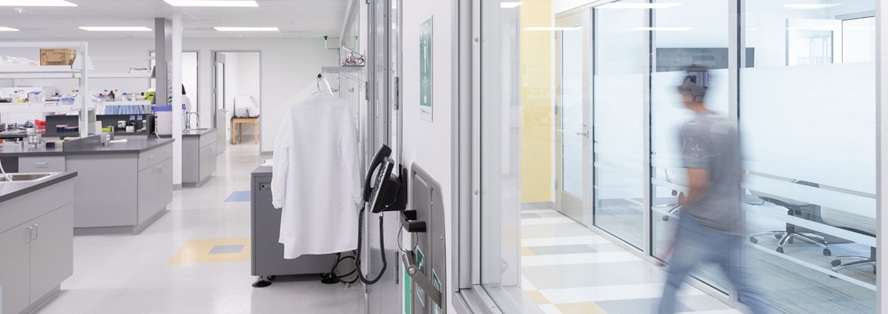I’ve seen many labs make mistakes when choosing between these two pieces of equipment – laminar flow hood vs biosafety cabinet. They might look similar, but they serve very different purposes. Their main difference lies in what they protect – the samples, the user, or both. Using the wrong one can lead to contaminated experiments or safety risks.
Understanding the Basic Differences
Laminar flow hoods only protect your samples from outside contamination. They push clean, filtered air across your work surface in one direction. Think of it like an invisible shield that keeps dust and other particles away from what you’re working on. However, these hoods offer no protection for the person using them.
The biosafety cabinet is much more protective. The fundamental principles of biosafety cabinet operation is to create a safe workspace that protects three things at once: your samples, you, and the lab environment. Clean air flows down from the top of the cabinet while also creating an invisible barrier at its opening. This design keeps harmful materials inside the cabinet where they belong. Here n, you can get more information from this source.
I use laminar flow hoods when working with materials that need to stay clean but aren’t dangerous. Making sterile culture media or preparing DNA samples works well in these hoods. The filtered air keeps everything pristine.
Biosafety cabinets are essential when working with potentially harmful materials. If you’re handling bacterial cultures, human blood samples, or viruses, you must use a biosafety cabinet. These cabinets use special filters and air patterns to contain anything dangerous.
Choosing the wrong type can have serious consequences. Research and accident reports have revealed the seriousness of these risks. For example, some research indicates that when dealing with high-risk pathogens such as Brucella, a significant proportion of laboratory infections occur during operations outside the biosafety cabinet or due to cabinet failures.
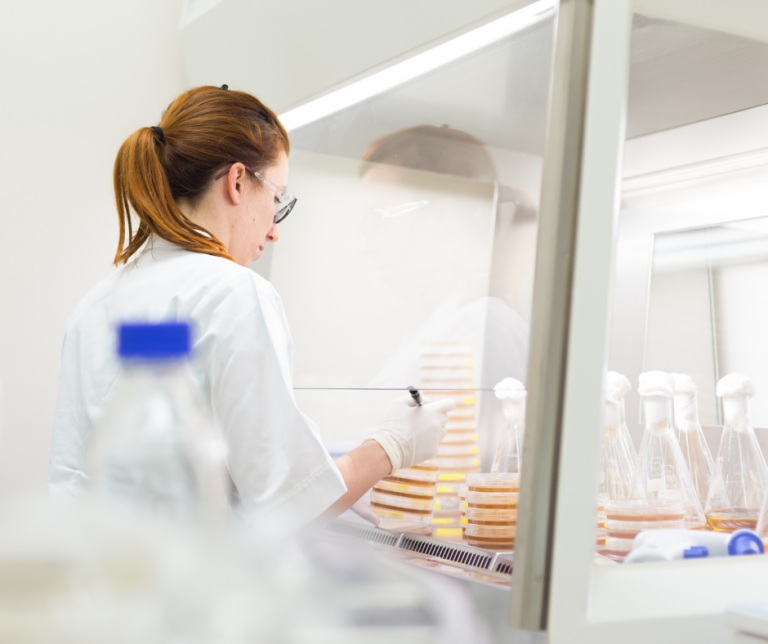
Working with dangerous materials in a laminar flow hood could spread harmful particles throughout the lab. This mistake could make people sick or ruin other experiments nearby. The choice between these two pieces of equipment isn’t just about preference – it’s about safety and getting reliable results.
Remember this simple rule: if what you’re working with could harm you or others, use a biosafety cabinet. If you just need to keep your samples clean and they’re not dangerous, a laminar flow hood will work fine. Making the right choice keeps everyone safe and your research accurate.
Understanding Airflow and Filtration: The Key Differences Between Safety Cabinets
How Clean Air Equipment Works
Lab safety equipment comes in two main types. Each type moves and filters air differently to protect different things in the lab. Understanding these differences helps lab workers choose the right equipment for their work.
Laminar Flow Hoods: Clean Air for Your Samples
A laminar flow hood keeps your samples clean and free from contamination. Clean air flows in one smooth direction across your work area. The air first passes through a special filter called a HEPA filter, which removes nearly all tiny particles.
These hoods come in two styles. Horizontal hoods blow clean air from back to front, straight toward the user. Vertical hoods push filtered air down from the top of the cabinet onto your work surface. Both types are great for working with materials that need to stay clean, like computer parts or cell cultures.

But these hoods have a big limitation. While they protect your samples from dust and germs, they don’t protect you from anything harmful in your samples. All the air blows right out into the room where you’re working.
Biosafety Cabinets: Protection for Everyone
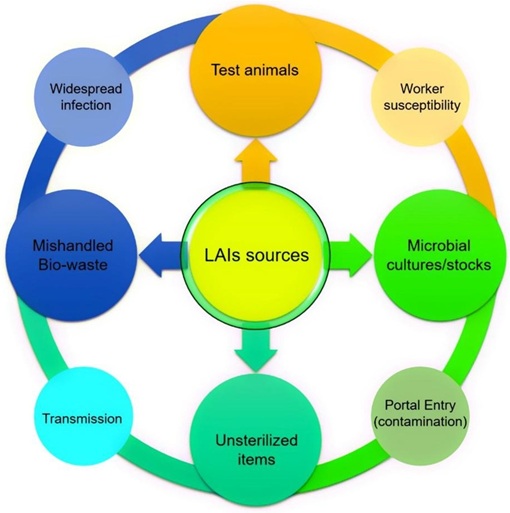
Biosafety cabinets are much more protective than regular laminar flow hoods. They shield three things at once: you, your samples, and the lab environment. These cabinets use clever air patterns to create this protection.
Historical data and research emphasize that inhaling harmful aerosols generated by experimental operations is one of the most significant routes leading to laboratory – acquired infections (LAI).
Some statistics even suggest that up to 80% of such infections are related to aerosols.
This is precisely why the correct selection and standardized use of biological safety cabinets are of crucial importance, as one of their core design objectives is to effectively control and capture these dangerous aerosols.
Air flows into the cabinet’s front opening, creating an invisible barrier. This keeps dangerous particles from floating out toward you. Clean, filtered air flows down over your work area to protect your samples. Before any air leaves the cabinet, it passes through another HEPA filter.
Different types of biosafety cabinets exist for different kinds of work. It is important to understand biological safety cabinet classes: Class I cabinets protect only the worker and environment. Class II cabinets – the most common type – protect everything: worker, samples, and environment. Class III cabinets provide the highest protection for extremely dangerous materials.
While all biosafety cabinets aim to protect you, your samples, and the lab environment, it’s vital to understand that not all Class II cabinets—the most common type you’ll encounter—are created equal, especially when chemicals are involved. Think of Class II cabinets as having different ‘flavors,’ known as subtypes like A2, B1, or B2. The main difference lies in how they handle the air inside and what they do with it.
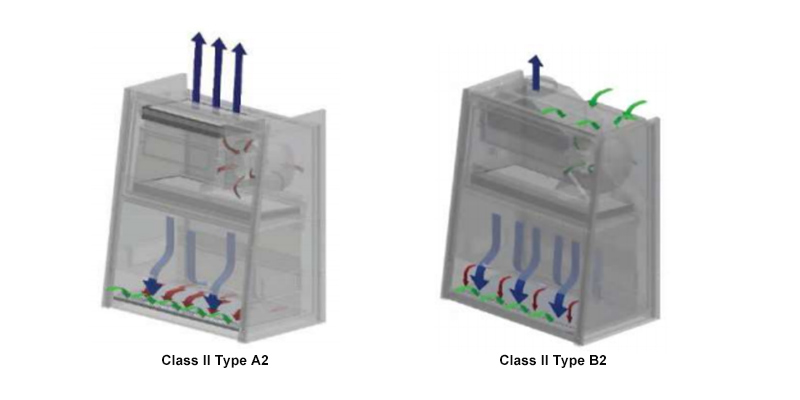
Some, like Type A2 cabinets, clean and recirculate a large portion of the air back into the workspace and can exhaust a smaller portion back into the lab or, if working with tiny amounts of chemical vapors, can be connected to an exhaust system. However, if your work involves more significant amounts of hazardous chemical fumes or radioactive materials alongside your biological samples, you’ll need a cabinet designed for that.
Type B2 cabinets, for instance, don’t recirculate any air; instead, they are directly connected to an external exhaust system, pulling all potentially contaminated air (including chemical fumes) completely out of the lab after filtering.
Choosing the correct Class II subtype is absolutely critical: using a cabinet that recirculates air when you’re working with volatile chemicals could expose you and the lab to those fumes, as standard HEPA filters only trap particles, not gases or vapors.”
This equipment might look similar on the outside, but their differences matter a lot for lab safety. Choosing the right one depends on what you’re working with and what needs protection.
| Feature | Laminar Flow Hood (Clean Bench) | Biosafety Cabinet (Typical Class II) |
|---|---|---|
| Primary Purpose | Product protection from external contaminants | Operator, product, AND environmental protection from internal hazards |
| Operator Protection | None (Poses a risk if hazardous materials are used) | High |
| Product Protection | High (from external contaminants) | High |
| Environmental Protection | None (from hazards within the hood) | High |
| Airflow (Operator) | Horizontal: Towards operator | Inward air curtain at front opening |
| Vertical: Not directly at, but room exhaust. | Inward air curtain at front opening. | Downward unidirectional HEPA-filtered air. |
| Airflow (Work Surface) | Unidirectional HEPA-filtered air (horizontal or vertical) | Downward unidirectional HEPA-filtered air. |
| Typical Air Exhaust | To the room (often unfiltered from work surface) | HEPA-filtered (to room or ducted outside). |
| HEPA Filter Locations | Supply air only | Supply and exhaust air. |
| Suitable for Biohazards | No (Never) | Yes (BSL-1, 2, 3 depending on Class/Type). |
| Suitable for Volatile Toxic Chemicals/Radionuclides | No | Varies by Type (e.g., Type B2 preferred; Type A limited/requires ducting). |
| Common Applications | Sterile media prep, non-hazardous cell culture, electronics assembly. | Work with infectious agents, human cell lines, aerosols |
Table: Comparative Levels of Protection – Laminar Flow Hood vs. Biosafety Cabinet (Typical Class II)
How to Choose: Laminar Flow Hood vs Biosafety Cabinet
A laminar flow hood and biosafety cabinet serve different purposes in the lab. These tools help scientists work safely with different materials, but choosing the wrong one can be dangerous. The key is knowing exactly what you plan to work with and what kind of protection you need.
When to Use a Laminar Flow Hood
Laminar flow hoods protect your samples from dust and other tiny particles in the air. They blow clean, filtered air across your work space in one direction. These hoods are perfect for working with materials that won’t harm people.
Use a laminar flow hood when:
- Making sterile growth media with safe ingredients
- Putting together clean equipment
- Growing harmless plant tissues
- Making safe medical products that need to stay clean
- Setting up DNA tests with non-harmful samples
The hood’s clean air keeps your work free from contamination. However, it offers no protection for the person using it.
When You Must Use a Biosafety Cabinet
Biosafety cabinets protect you, your samples, and the lab environment. They’re not optional when working with harmful materials. The filtered air in these cabinets flows in a special pattern to contain dangerous substances.
You need a biosafety cabinet for:
- Working with germs that can cause disease
- Handling blood, cells, or tissues from humans or animals
- Any work that creates droplets or sprays
- Special DNA work that needs containment
- Some cancer-causing substances
Never use a laminar flow hood for these tasks. It would blow harmful materials right at you.
A Note About Chemical Fume Hoods
Chemical fume hoods are different from both tools above. They protect users from chemical vapors and fumes. These hoods pull air away from the user and send it outside. They don’t keep your samples clean, and they don’t work for containing biological materials.
Choose your work station based on what you’re handling. When in doubt, ask a lab safety expert for guidance.
Choosing Between a Laminar Flow Hood and Biosafety Cabinet
Making the right choice between these two pieces of lab equipment is crucial for your safety and success. Each device serves different purposes in the lab, and picking the wrong one could put you or your work at risk. Understanding a few key factors will help you make the best choice for your needs.
Assess Your Risks First
You need to know what you’re working with before buying any equipment. Think about three simple questions:
Thinking through the risks before you even choose, let alone use, a hood or cabinet is the most important first step. It’s not just a quick thought; it’s a careful evaluation. You really need to dig into the specifics.
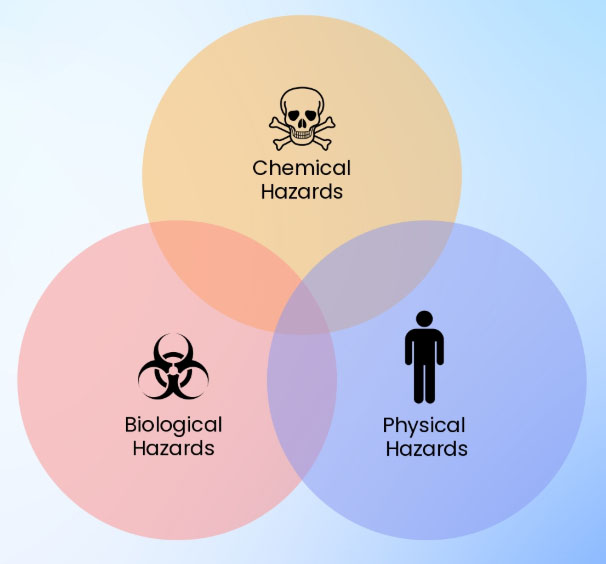
What exactly are you working with? Consider the biological agent itself – how infectious is it, how does it spread, and how much of it are you using? Larger amounts or more dangerous agents naturally need more protection.
What lab procedures will you be doing? Things like shaking, mixing, or pipetting can create tiny airborne droplets (aerosols) that might carry hazardous material.
Will any chemicals be involved? If you’re using volatile chemicals alongside your biological samples, this hugely influences your choice because, as we’ve discussed, not all cabinets can safely handle chemical fumes.
Who or what needs protection? Sometimes you just need to keep your samples clean. Other times, you need to protect yourself and others in the lab. The most demanding work requires protecting your samples, yourself, and the environment all at once.
Answering these questions systematically helps ensure you pick equipment that truly keeps you, your samples, and your lab safe.
Understanding Safety Levels
When we talk about lab safety, you’ll often hear about Biosafety Levels, or BSLs. These are like official safety rankings – BSL-1, BSL-2, BSL-3, and BSL-4 – each describing the level of risk from the biological materials you’re handling and the specific safety practices, equipment, and lab design needed.
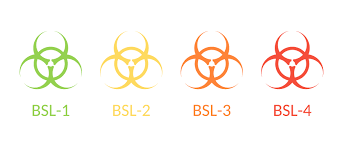
For example, BSL-1 is for work with well-known microbes that aren’t generally harmful to healthy adults, and you might just work on an open bench. But as you move up, say to BSL-2, you’re dealing with agents that can cause human disease, often through accidental skin puncture, ingestion, or splashes. For these, a Biosafety Cabinet, typically a Class II, becomes essential if your work might create those splashes or airborne particles (aerosols).
Higher levels like BSL-3 and BSL-4 involve even more dangerous agents and require even more specialized cabinets (like Class II or Class III BSCs) and stricter lab designs. So, understanding the BSL of your work is a crucial first step in figuring out if you need a BSC and what kind.
Practical Matters to Consider
Biosafety cabinets need more space than laminar flow hoods because of their design. You’ll need to think carefully about where to put either piece of equipment. The location matters because air flow in the room can affect how well they work.
Laminar flow hoods cost less to buy and maintain. Biosafety cabinets cost more up front and need yearly safety checks. A biosafety cabinet needs to be professionally tested and certified: when it’s first installed, at least once a year after that, and also anytime it’s moved, if major repairs are done (like a motor change), or if its HEPA filters are replaced.
Think of certification as a thorough health check-up for your cabinet. Trained technicians will perform a series of tests, like checking if the airflow is moving at the right speed and in the right direction to protect you and your samples, making sure the HEPA filters aren’t leaking, and even using smoke to see that the air curtain at the front is working properly. This isn’t something you can just eyeball; it requires special equipment and expertise to confirm your cabinet is truly providing the protection it’s designed for.
However, choosing the wrong equipment to save money can lead to serious problems. These problems could include contaminated experiments or safety risks that end up costing much more in the long run.
Your choice should always put safety first. The extra cost of the right equipment is worth it when it protects you and your work. Remember that cutting corners on safety equipment usually leads to bigger problems later.
Key Things to Know About Lab Safety Equipment: Laminar Flow Hoods vs. Biosafety Cabinets
Lab safety depends on choosing the right equipment. These choices can mean the difference between safe work and putting people at risk. Knowing the differences between laminar flow hoods and biosafety cabinets helps prevent dangerous mistakes.
Common Mistakes People Make
“This hood will protect me from harmful samples.” Wrong! Laminar flow hoods only provide clean air for your samples. The air flows either straight at you or down from above, which can actually blow dangerous particles into your face. A biosafety cabinet is what you need for protection.
A common and dangerous mistake is thinking that any equipment with a HEPA filter—those special air filters—is automatically safe for all dangerous materials, including chemical fumes. This is a critical misunderstanding. Here’s the key: HEPA filters are fantastic at trapping tiny particles like dust, bacteria, and even viruses if they’re riding on larger particles. However, they absolutely DO NOT remove chemical vapors or gases. Imagine trying to catch smoke with a colander; the smoke just goes right through. It’s the same with HEPA filters and chemical fumes.
If you’re working with volatile chemicals, even in a biosafety cabinet, you must ensure it’s the right type (like one that ducts fumes outside), because the HEPA filter alone won’t protect you from those chemical vapors
“I can use a regular hood for simple biological work.” Think again. Even with low-risk materials, a biosafety cabinet is usually better. It protects everyone in the lab, especially when many people use the equipment. Students and new lab workers benefit from learning proper safety habits early.
Serious Safety Errors to Avoid
Never use a laminar flow hood for any dangerous biological materials. This mistake could lead to serious infections. Biosafety cabinets exist specifically for this kind of work.
Some people try to make laminar flow hoods safer by adding plastic shields. This is extremely dangerous. These changes mess up the air flow and give false security. You can’t turn a basic hood into a safety cabinet with simple modifications.
Watch where you put things in your work space. Blocking air vents or moving too quickly can make safe equipment unsafe. Good training matters as much as having the right equipment. Simple actions can keep everyone safe when working with biological materials.
Remember: When in doubt, choose the safer option. A biosafety cabinet might cost more, but it’s worth it to protect yourself and others in the lab.
Conclusion: Making the Safe Choice for Your Lab
Understanding Your Protection Needs
The choice between a laminar flow hood and biosafety cabinet comes down to one key question: What needs protection? A laminar flow hood only keeps your samples clean with filtered air. In contrast, biosafety cabinets protect everything – your samples, you, and the environment around your workspace.
When to Choose Higher Protection
Playing it safe is always smart in the lab. Sometimes you might not be totally sure how dangerous your samples are. The safe move is picking a biosafety cabinet, which gives you more protection than a laminar flow hood. It’s better to have extra safety features than to wish you had them later.
Getting Expert Input
Talk to your lab safety team before making your final choice. They know the rules and can look at your specific needs. Every lab has its own safety guidelines that you need to follow. The CDC and NIH also have rules about working with biological materials that might affect your choice.
For example, in North America, a major standard called NSF/ANSI 49 spells out exactly how Class II biosafety cabinets should be built, how well they must perform, and how they should be checked.
Health authorities like the CDC (Centers for Disease Control and Prevention) and NIH (National Institutes of Health) also publish comprehensive guidelines, such as the ‘Biosafety in Microbiological and Biomedical Laboratories’ (BMBL) 6th Edition, which is a go-to resource for labs working with infectious materials.
Even workplace safety organizations like OSHA have regulations concerning their proper use. These standards and guidelines aren’t just red tape; they are there to make sure the cabinet does its job reliably and keeps everyone safe by defining what ‘safe’ and ‘effective’ really mean for this critical equipment.
Safety Comes First
Your choice of equipment does more than just help your experiments succeed. A wrong choice could put people at risk or ruin your research results. Take time to think about what you’re working with and who needs protection. The right decision will keep everyone safe and help your lab work go smoothly.
Remember, choosing the right laminar flow hood or biosafety cabinet is a vital piece of the lab safety puzzle, but it’s not the only piece. Even the best cabinet/hood can’t protect you if it’s not used correctly or if other safety practices are ignored. Think of lab safety as having layers. The cabinet itself is a powerful engineering control – it’s designed to contain hazards.
But this works best when combined with good lab practices (like how you move and work inside the cabinet), proper training so you know what you’re doing, and wearing the right Personal Protective Equipment (PPE) like gloves and lab coats. All these elements work together to create the safest possible environment for your important research.

